Prices of non ferrous metals: analysis of their trend and outlook

While facing the current critical situation, it is natural for anyone to look for information, regardless of whether the causes are the Coronavirus pandemic, the skyrocketing price of raw materials, the Russia-Ukraine War, or the economic and socio-political dynamics resulting from these unprecedented events. Furthermore, it is inevitable to seek after possible future scenarios concerning the markets. Specifically, focusing on the companies which, like RMG, use non ferrous metals to produce copper based alloy ingots, it is necessary to find out reliable information concerning the price and stock trends of the main raw materials at the base of their manufacturing activities.
What is the scenario for aluminium, copper, nickel, zinc, lead, and tin?
The trend of these metals has an impact on the output of both the refineries like RMG which produce copper based alloys and all the companies belonging to their supply chain; that is, those whose production is based on the use of bronze, aluminium bronze, and other alloy ingots. The areas of application for our ingots are many and different:
- Propellers, cleaners, valves, and pumps for the maritime industry;
- Bearings, gears, and bushings;
- Statues, bells, and artistic applications;
- Valves and connectors for drinking water;
- Glass mouldings.
Thanks to the information provided during the 37thedition of the Circumstances Observatory “Scenari & Tendenze” (lit. Scenarios and Trends), organised by Confindustria Brescia, attendees have the chance to dig deeper into the situation of non ferrous metals up to March 2022 and to understand what are the relating forecast. Let’s start with a general overview, then we will analyse the trend of main non ferrous metals.
Mean of all non ferrous metals quoted on LME based on weekly averages – Trend up to 29th March 2022
Looking at the graphics of the average of all non ferrous metals based on weekly averages, the mean performance is as follows:
- 2020: there is a rising trend of +20.2%;
- 2021: a further increase in the mean prices can be seen (+52.2%);
- 2022: in the period between January and mid-March there is a peak of +43.4%, which is followed by a correction (-15.5%). This trend can be observed in each metal.
The latest performance is ascribable not to a gap between supply and demand, but rather to a financial factor. The subsequent correction takes the edge off.
Concerning the mean of volumes, we can observe a significant decrease of 62.2% in the last year, which keeps prices at high levels. This situation of stocks is mainly due to the shortage of demand during the pandemic and the following explosion in the request for raw materials. Furthermore, both the average and single volumes are at a minimum level, thus causing concerns.
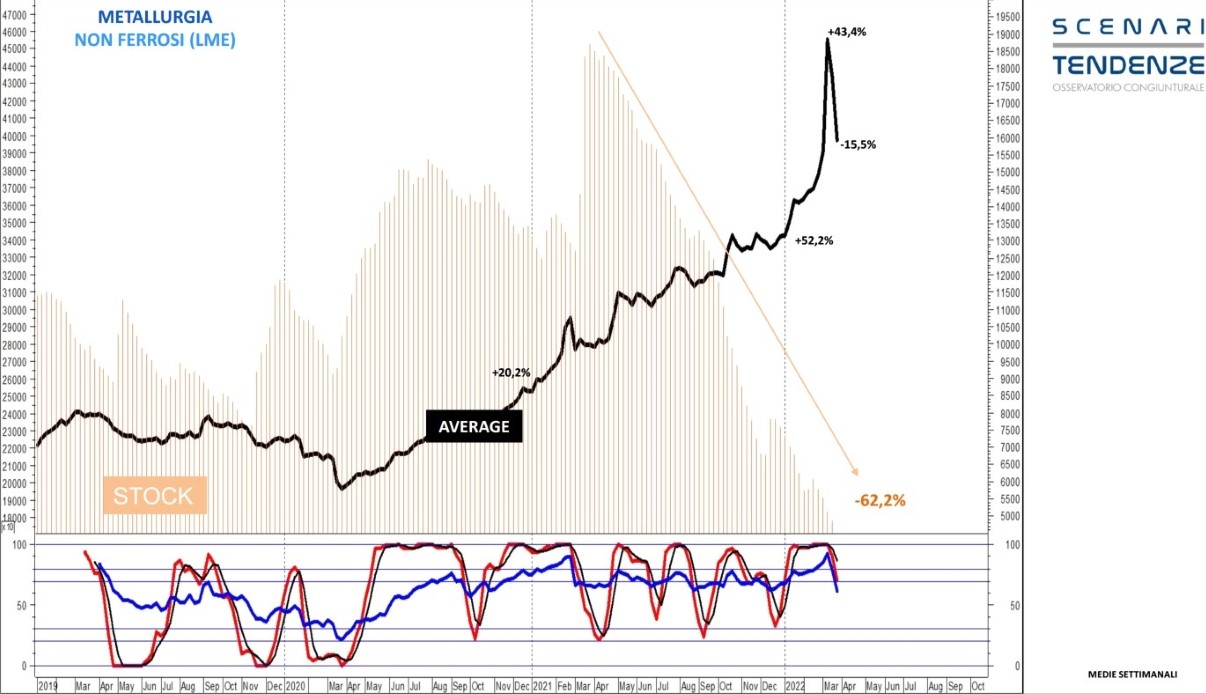
Aluminium - weekly averages (US$/MT)
Aluminium is the energy-intensive metal par excellence. Let’s analyse the trend of its price:
- 2021: aluminium increases by +11.8% first and then undergoes a further surge in price (+41.8%);
- 2022: the year begins with a price rise of +28.4%, which is followed by a slight correction first (-8.5%) and then by another increase (+7.7%).
The significant fall in volumes of -64.5% supports the increasing trend of aluminium. As a result, a long-term and constant decrease in price can’t be expected. Furthermore, the Russia-Ukraine war is worsening the situation of stocks due to the interruption in the Russian and Ukrainian supplies of aluminium, thus reducing the available volumes which can’t meet the demand for this metal.
There is a risk of a shortage of aluminium, a non ferrous metal that is extremely important for the processing industries.
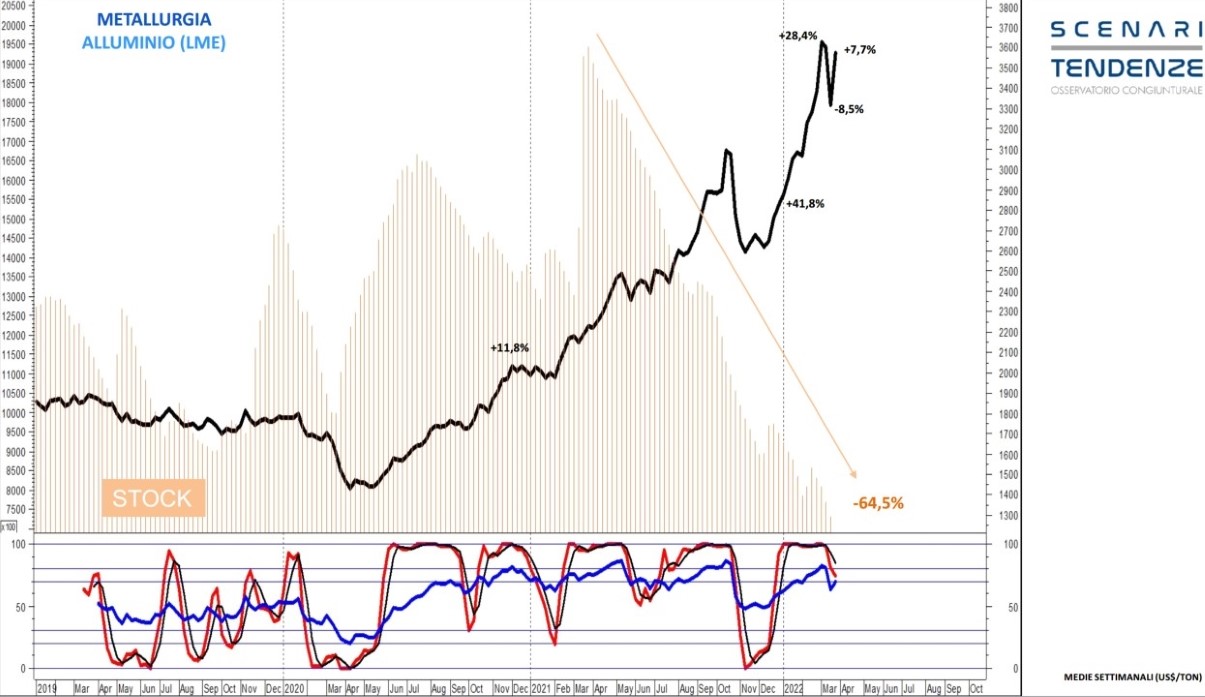
Copper - weekly averages (US$/MT)
Copper is not only the essential element of our production of bronze, aluminium bronze ingots, and other special alloys, but also an important raw material that is used by many companies in Brescia. The trend of this metal is quite different from the one of aluminium:
- 2020: after the spread of the pandemic, the price of copper rises by +26%;
- 2021: a further increase in price occurs (+24.2%), but it is quite moderate if compared with the trend of aluminium;
- 2022: the price keeps on with increasing trend (+6.4%), but now it is settling on these levels. It should be pointed out how these are higher than the top levels of 2019, which is the reference point before 2020.
If we consider copper stocks, it’s clear that also for this metal there is a considerable reduction (-68.4%) which influences the price, thus supporting its increase. Furthermore, if Chile and Peru should potentially intensify the taxes on mining activities the situation of copper could even worsen since these countries are among the most important supplier of this metal.
What is the forecast? The demand for this non ferrous metal won’t decrease and its price is expected to keep on with this slightly rising trend.
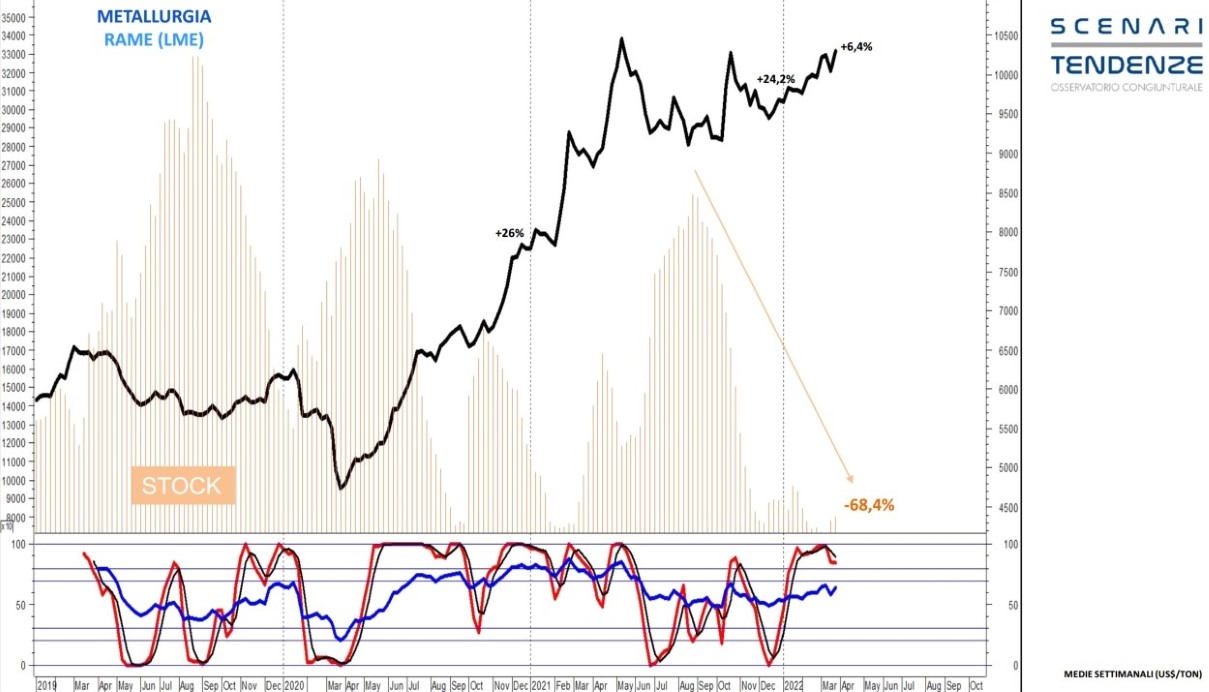
Nickel - weekly averages (US$/MT)
Looking at the price of nickel on weekly averages, in 2022 it is possible to see an extraordinary rise of +140.3% which is mainly due to the following causes:
- The dynamics which are related to the war;
- Significant financial causes.
Considering the significant worldwide role played by Russia in supplying nickel, this metal is affected by the current lack of Russian supplies on the market. It’s important to point out how the actions which were undertaken on financial markets to relieve tension have caused a decrease in nickel price of -37.1%. As a result, the nickel price should go back to levels that aren’t influenced by financial dynamics.
With regards to the volumes of nickel, it’s clear that they are plummeting (-72%). The war and, as a result, the lack of Russian supplies of nickel on the official market are certainly intensifying the critical situation of nickel stocks.
The current price correction is expected to continue until it will settle on lower levels which, anyway, will be higher, but with fewer oscillations, than the average price of the last year.
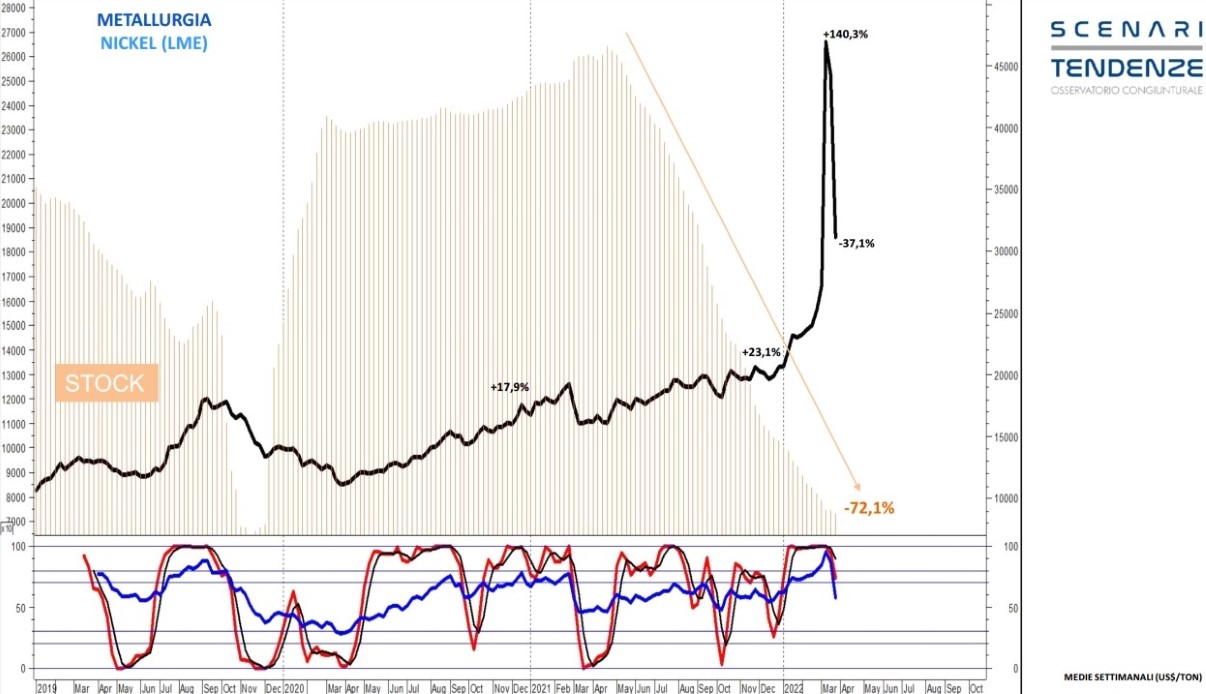
Zinc - weekly averages (US$/MT)
If compared to copper but most of all to aluminium, zinc price has a similar trend, since after these metals it is one of the most used for production. Up to March 2022, an increase in the price of +11.7% can be observed which is combined with the lowering of volumes (-51.3%). This situation of zinc stocks, in turn, supports the rising trend of price.
According to projections, the demand for this metal will grow. As a result, the expected adjustment of the price will settle at high levels.
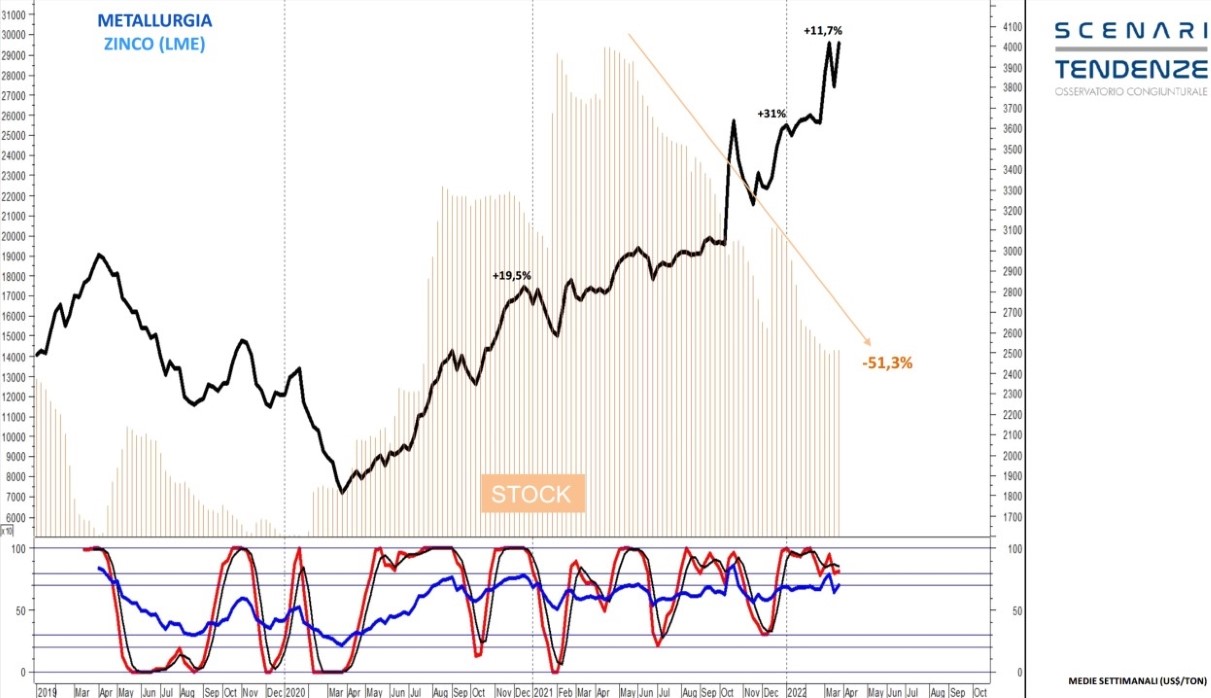
Lead - weekly averages (US$/MT)
Concerning the situation of lead, it’s possible to observe a price increase also in this case. A rise is caused by the significant provisions of this non ferrous metal after the pandemic to produce batteries for internal-combustion engines. Let’s analyse the price trend:
- 2020: increasing trend of +27% with intense fluctuations;
- 2021: a further rise in price can be observed (+18.4%) which, despite being on high levels, is now moving laterally.
For what concerns lead stocks, it is possible to see a fall in volumes of -71.7%.
Furthermore, we should be aware that next-generation of electric vehicle batteries are becoming more popular than those used for starting internal-combustion engines, thus contributing to the reduction in demand for lead. The future scenario is clear if we look at the trend of those raw materials used in lithium-ion batteries, among which we find nickel and lithium carbonate (+485.3% in 2021 and +82.5% up to March 2022). In such a situation there’s a risk related to the high price level of these materials, which could make the transition towards sustainable mobility difficult since the costs of these raw materials couldn’t be bearable in the long term.
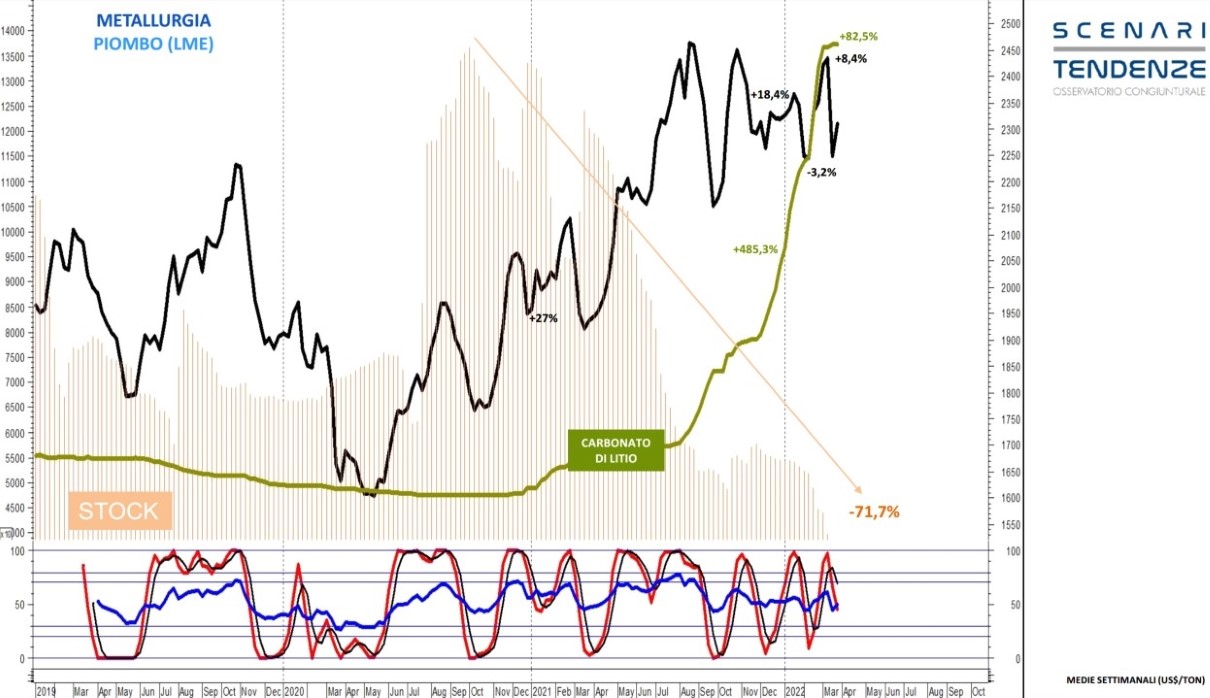
Tin - weekly averages (US$/MT)
The situation of tin is consistent with what has been said above:
- 2021: we can see an extraordinary increase in the price of +93.7%;
- 2022: the price keeps on with this trend (+16.5%).
Forecast for tin? The demand is expected to grow and its use in electronics for the production of integrated circuits will increase as well.
Concerning the volumes of tin, they have plummeted since the beginning of 2020 (-69.4%). This decrease together with the environmental restrictions set by Indonesia and Myanmar - two of the most important producers of tin – are causing an imbalance in the lacking supply and the more and more increasing request for material.
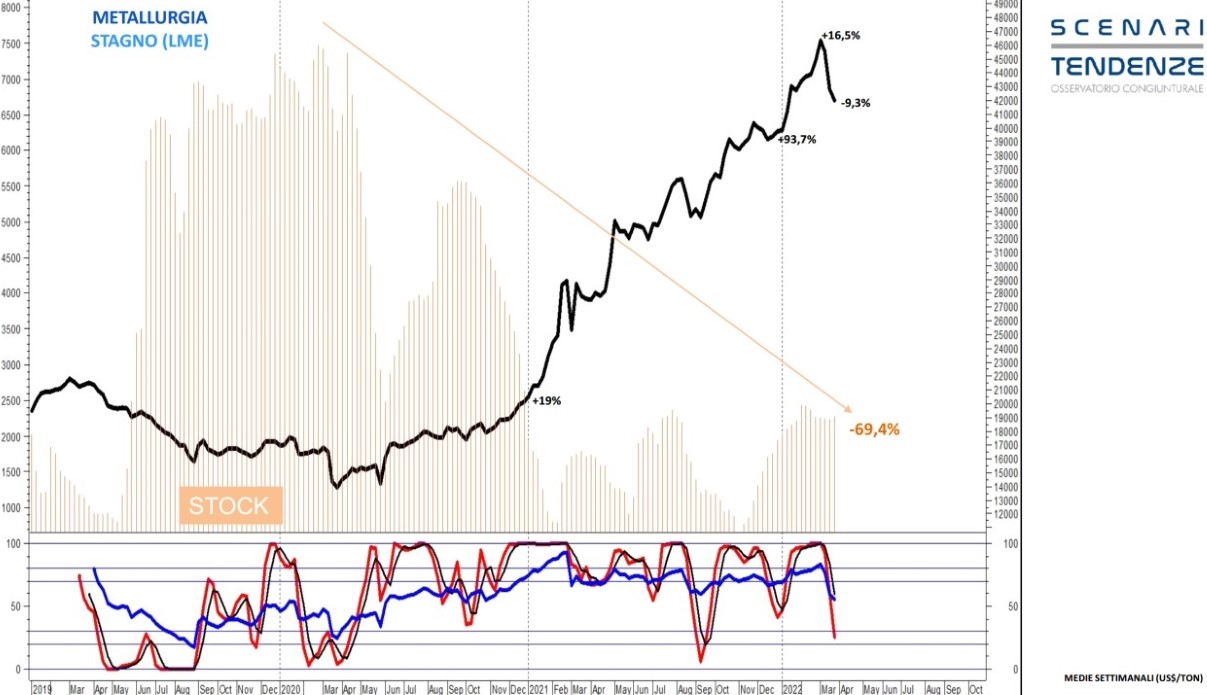
Source: Confindustria Brescia - "Scenari & Tendenze", 29th March 2022.